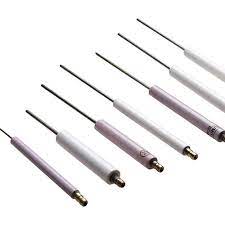Ignition Electrodes





Ignition Electrodes
Ignition electrodes are critical components in burner systems, providing the necessary spark to ignite the fuel-air mixture for combustion. Whether used in industrial boilers, home furnaces, or gas appliances, ignition electrodes ensure the efficient and safe operation of heating systems. Below is a detailed overview of their construction, operation, and maintenance.
Key Components and Characteristics:
- Material:
Ceramic Insulator:
Ignition electrodes are commonly equipped with a ceramic insulator, which provides high electrical insulation, ensuring that the electrode can withstand high temperatures without the risk of electrical leakage.Metal Electrode Tips:
The electrode tips are typically made of conductive metals such as stainless steel to ensure durability and efficient spark generation. The tips directly interact with the fuel-air mixture to initiate ignition.
Electrode Configuration:
Spark Gap:
The spark gap refers to the distance between the electrode tips. This gap is crucial for the formation of a spark, and the size must be correctly calibrated to ensure proper ignition. An incorrect spark gap can lead to ignition failure or inefficient combustion.Shape and Design:
Ignition electrodes come in various configurations such as single electrodes, dual electrodes, or even custom designs depending on the specific burner requirements. Different designs cater to different types of burners and fuel types.
Working Principle:
High Voltage Generation:
- Ignition electrodes work in conjunction with a transformer or an ignition module that generates high voltage across the spark gap.
Spark Formation:
- When the high voltage is applied to the electrode, it ionizes the air between the electrode tips, forming a spark or arc. This spark is responsible for igniting the fuel-air mixture.
Ignition of Fuel-Air Mixture:
- The spark ignites the fuel-air mixture, initiating the combustion process and starting the burner.
Applications:
Industrial Boilers:
Used in large industrial boilers for the ignition of fuels such as natural gas or oil, providing reliable performance in demanding environments.Home Heating Systems and Furnaces:
Found in residential furnaces and home heating systems, ensuring efficient fuel ignition for comfort heating.Gas Appliances:
Utilized in everyday gas-powered appliances like cooktops, water heaters, and ovens, where reliable ignition is essential for safe operation.Industrial Burners:
Deployed across various industries, including manufacturing and processing, where ignition electrodes facilitate large-scale combustion processes.
Maintenance and Considerations:
Regular Cleaning:
Ignition electrodes should be cleaned periodically to remove carbon deposits or other contaminants that may accumulate on the electrode tips, which can hinder spark formation and efficient combustion.Regular Inspection:
Routine inspections are essential to check for any damage to the ceramic insulator or electrode tips. Wear and tear on the electrodes can lead to poor performance and potentially dangerous conditions.Proper Alignment:
The correct alignment of the electrodes is critical to ensure consistent and reliable sparking. Misaligned electrodes can cause ignition failure or incomplete combustion.Timely Replacement:
Over time, ignition electrodes can wear out or become damaged. It is crucial to replace them promptly to avoid operational inefficiencies or the risk of system failure.
Ignition electrodes are fundamental to the safe and efficient functioning of burner systems in a wide array of applications, from industrial settings to residential appliances. Proper maintenance—including cleaning, inspection, alignment, and timely replacement—is essential for prolonging the life of these components and ensuring consistent performance. By ensuring the correct operation of ignition electrodes, users can optimize fuel combustion, improve energy efficiency, and maintain safety in gas-powered systems.